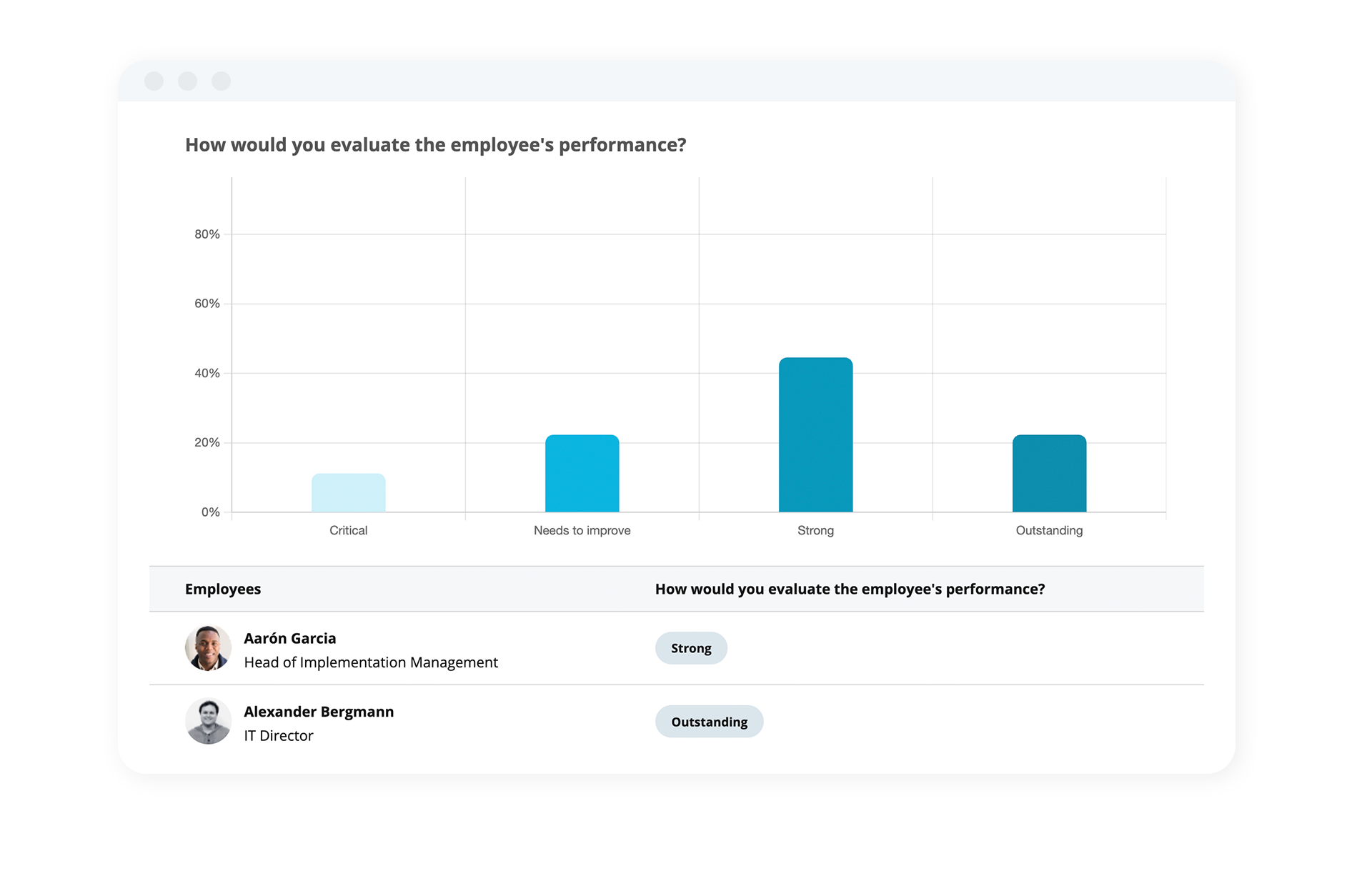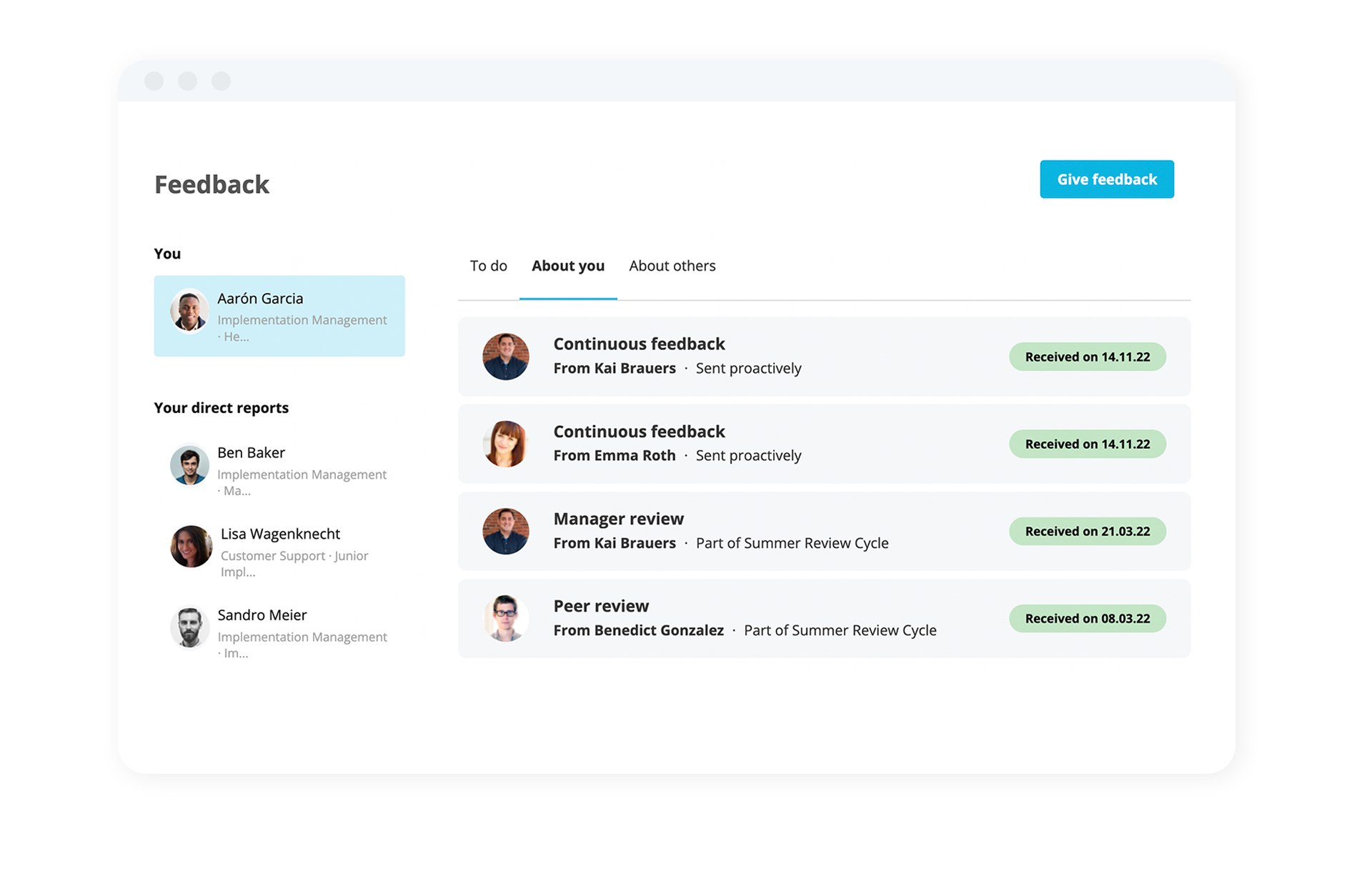9 ways to effectively track employee performance in 2024
Every company wants to get the most out of its workforce. And that means carefully tracking employee performance over time so you can give kudos where they’re due, spot any problems and help employees improve. Read on for our top tips for tracking employee performance in 2024.
Develop a targeted HR strategy today with this handy guide.9 tips for tracking employee performance
Ready to jump in? Here are our nine top tips for tracking employee performance this year:
1. Set clear goals and objectives for each employee

To effectively track employee performance, you first need to properly define your expectations. This both helps employees to understand what they’re working towards, and allows you to measure whether or not they have been successful.
When you’re setting goals for employees, you should use the SMART framework. This means that each goal should be specific, measurable, achievable, relevant and time-bound.
Here’s an example: a marketing manager wants to improve their company’s performance on social media. So, they set a SMART goal for the social media manager to increase engagement on their main channel by 10% per quarter by the end of the year. This goal is:
Specific: It includes concrete details about the goal, including the channel and the objective (to increase engagement).
Measurable: It includes a numerical target of 10% per quarter.
Achievable: It can be done through consistently applied paid and organic strategies.
Relevant: It’s directly related to the social media manager’s role.
Time-bound: It needs to be achieved by the end of the year.
It’s also important to involve employees in the process of setting their own goals. This makes them much more likely to be motivated to achieve them.
2. Select key performance indicators (KPIs) to measure success
Key performance indicators (KPIs) are quantifiable performance metrics that companies track over time to measure progress towards their strategic goals. By setting the right KPIs (and tracking them over time) you can get an overall view of employee performance across your team or organisation.
A KPI should be a concrete, measurable target that’s ambitious but achievable. There are lots of different KPIs you could set depending on your company's strategic priorities. For example, many companies set financial KPIs, which might include:
Total revenue
Revenue growth
Net profit
Profit margin
You might also set KPIs related to customer satisfaction, including:
Average ticket resolution time
Average response time
Net promoter score (NPS)
Looking for more ideas? Check out our articles on HR KPIs and recruitment KPIs.
3. Monitor performance throughout the year (not just at review time)
In many organisations, employee performance is only really considered once a year, at the employee’s annual review. But this isn’t a very effective way of measuring (and improving) employee performance.
Instead, managers should closely monitor performance all year round. The simplest way is to open up a performance file for each employee. Then, make a note every time you notice an employee completing a complex task, excelling at something or making a mistake.
This makes it much easier to put together a comprehensive review once performance appraisal season rolls around.
Performance Review Template: Host More Productive Conversations

Add more structure to your performance conversations today. Download our templates to help guide the conversation.
Download Now4. Provide regular feedback on performance
It’s also important to give your employees regular feedback on their performance. Providing this feedback while it's still fresh in both of your minds is much more useful to employees than waiting until their annual review.
Scheduling regular meetings with employees to discuss their performance also allows you to hear from them about how they’re progressing and any barriers they’re facing. This means you can help them to quickly overcome problems, and reassess goals if they’re no longer relevant.
5. Be careful with criticism
A big part of assessing and tracking performance is telling employees when something is going wrong. Employees don’t always know they have a problem until you point it out — and bringing it up is the first step towards helping them resolve it.
But it’s also important to be careful with how you deliver criticism, so you don’t upset employees or undermine their confidence. When you have something negative to say, you should keep it honest, relevant and specific. Backing it up with examples and talking about the potential results of the employee’s poor performance can also help them understand the issue.
Crucially, you should also be careful to keep any criticism to your employees’ behaviours or actions — not their personalities. This helps to keep things professional and productive. Struggling to find the words? Head to our ultimate list of performance review phrases for help.
6. Set up a fair and consistent performance review process

In most organisations, annual performance reviews are a big part of the performance management process. These reviews allow you to check in with employees about their progress towards long-term goals, identify areas where they need to improve and give praise where it’s due.
But if you want to use your performance reviews to accurately track employee performance over time, you need to make sure they’re fair and consistent across your organisation. When you use a tool like Personio to manage your performance reviews, you can set standardised performance appraisal forms and rating scales, ensuring everyone is graded according to the same criteria.
This gives you clean, accurate performance records that you can compare across different departments or over time.
7. Use 360° reviews to see the full picture

A manager can only know so much about their employees’ day-to-day work. After all, they have other employees to manage too, and they can’t be constantly watching over everyone.
In a 360° review, employees are reviewed not just by their managers, but also by their colleagues, reports and anyone else they come into regular contact with. Using 360° feedback is a valuable way of adding extra context to an employee’s review, creating a more holistic view of their performance.
8. Encourage employees to self-monitor
Part of the 360° review process involves asking employees to assess their own performance. But, like managers, employees shouldn’t only be thinking about their performance in the run-up to review season.
Managers should encourage employees to track their work against organisational KPIs and the goals they’ve set for themselves. This allows them to be more proactive in managing and improving their own performance — which can lead to better productivity across the organisation.
9. Track employee performance trends over time
Tracking performance trends over time helps managers, HR teams and company leaders to identify and respond to any changes in an employee’s performance. It allows you to spot problems early, giving you the best chance of resolving them quickly and efficiently.
For example, let’s say you notice a dip in performance in your customer service team. After arranging meetings with several members of the team, you discover the problem: a new piece of software that you recently implemented has made things more difficult by adding extra steps to the team’s processes.
In this case, you might then provide additional training on how to effectively use the software to get the team back on track.
Give Potential Room To Grow With Personio

Automate your performance cycles to open up time for job enrichment with Personio today.
Find Out More
The best tools for tracking employee performance
Most companies use a whole range of apps, platforms and software solutions to track employee performance. Here are some of the tools you might want to add to your belt in 2024:
Time-tracking tools
These tools help employees to track how they’re spending their time. Ultimately, this can help them to optimise their work processes and work more efficiently.
Managers can also use these apps to keep an eye on their employees' time usage, which enables them to spot and quickly resolve any problems. For example, if a manager notices that an employee is taking longer than expected to complete a particular task, they might offer extra training to help them improve.
Examples include: Clockify, Toggl Track
Task-management tools
These tools allow employees to keep track of the tasks they have on their plate. Managers can also use them to assign tasks to employees and then sort, filter and prioritise them. Essentially, they function like digital to-do lists that help employees to manage their workloads, and managers to assign work effectively.
Examples include: Todoist, ClickUp, ProofHub
Project-management tools
These tools go one step further than basic task-management apps, by allowing you to manage entire projects in one place. Using these tools, managers can set up workflows, assign tasks to particular employees and set a deadline for each one.
Project-management tools help everyone to understand how their work fits into a wider project by providing a clear view of all of the tasks involved. They also allow managers to track employee performance by keeping an eye on which tasks are completed on time.
Examples include: Monday, Asana, Trello
Employee monitoring tools
These tools allow managers to closely monitor their employees’ time, activity and productivity. To do this, they record how long each employee works each day, including their idle and active time. They may also monitor the apps and websites that employees use and the tasks they complete throughout the day.
Essentially, they give managers a full picture of how employees are spending their time, which can help them track performance. Crucially, these tools can also measure employees’ work-life balance, by tracking how much overtime employees are working each week. This can help managers to spot when someone is approaching burnout and step in to offer support.
A word of caution, though: some employees might find it a bit invasive or uncomfortable to know they’re essentially being watched the whole time they’re at work. If you choose to use employee monitoring software, you should reassure employees that it’s not about catching them out, but helping them to improve their working style and become more productive.
Examples include: Time Doctor, Insightful, Hubstaff
Easily track employee performance with Personio
Tracking employee performance can be a lot of work — but it doesn’t have to be if you have the right tools. Thanks to Personio, it’s never been easier to run consistent, effective performance reviews across your organisation.
You can set up performance cycles for the entire company in just a few clicks, and managers and employees will be automatically prompted to complete their reviews. They’ll even be able to schedule individual performance evaluation meetings right within Personio — without HR having to follow up.
Personio also lets you create customised forms and rating scales to make sure every review is fair and consistent. And you can view performance data for different teams and departments in an accessible, visual graph format — making it easy to pinpoint any problems.
Interested? Learn more about our performance management features or book a demo to see Personio in action.

